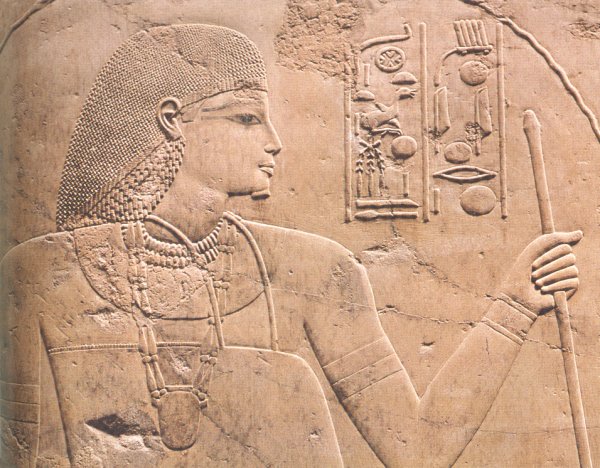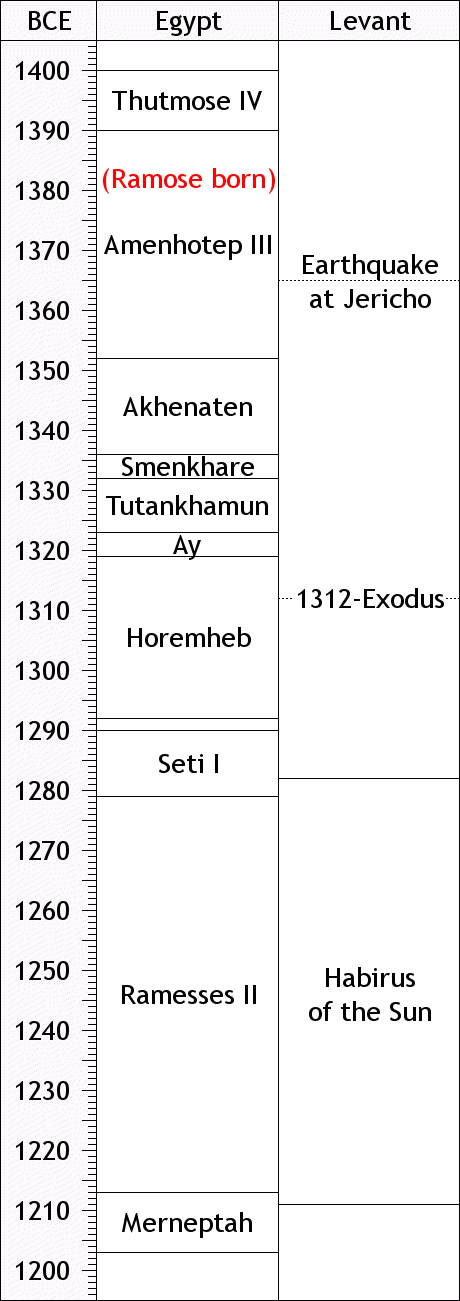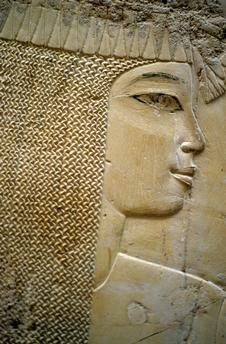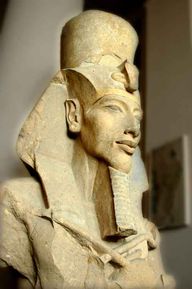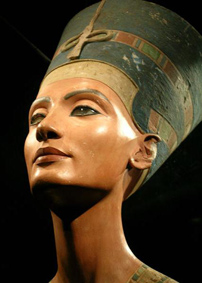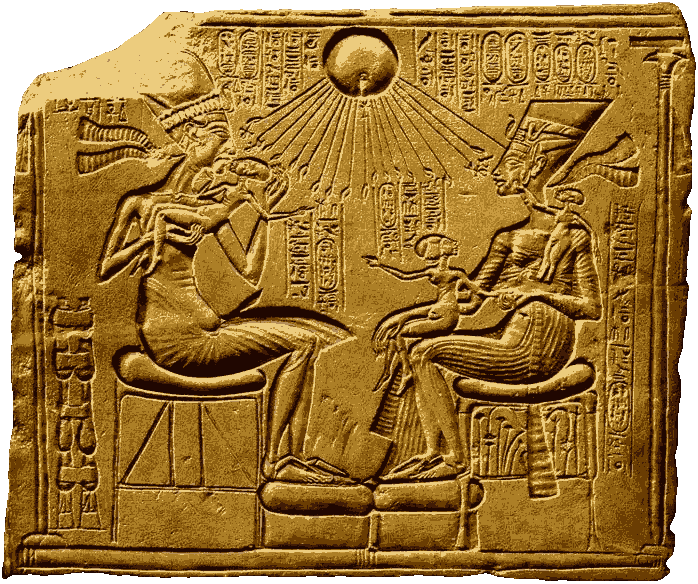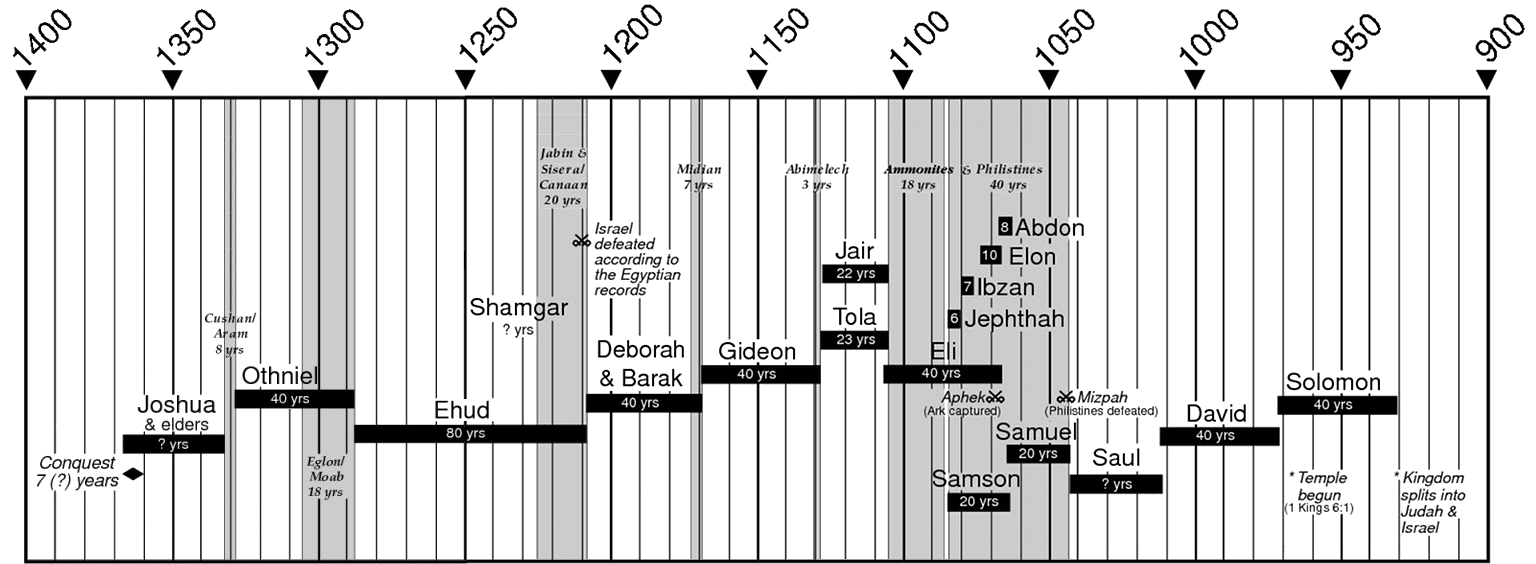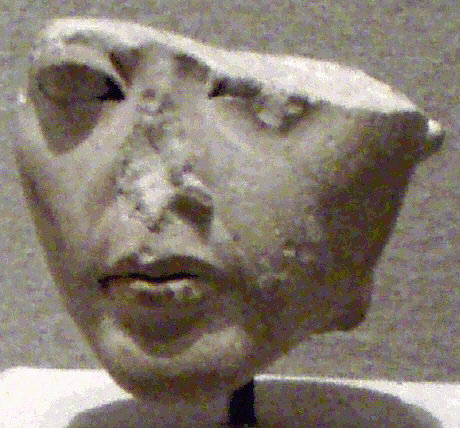© Charles ChandlerThe Egyptian at the heart of the story of the Exodus was Moses, no matter who told it. So who was he?The Torah says that his mother put him in a basket to drift down the Nile, starting just upstream of where the pharaoh's daughter was bathing, who found and adopted him.1 This was probably a renewal of the far older legend of Sargon the Great, who ruled Mesopotamia in the period of . But regardless of how Moses came to be raised at court, Josephus tells us that he rose to the rank of general in the Egyptian army.2:239 Later he fled to Midian (at the west end of the Arabian Peninsula, directly across the Gulf of Aqaba from the Sinai) to escape prosecution for killing an Egyptian who was beating a slave.3,4,5 When the plight of his followers in Egypt became desperate, Moses returned to negotiate on their behalf.6If there is any truth to this at all, Moses would have been important enough to show up in the secular records. The name "Moses" has never been found in any Egyptian document, but that doesn't necessarily mean much. In Egyptian this would have been "-mose," which was simply a suffix meaning "son," and which followed the name of the parent god (e.g., Ahmose, Thutmose). Since the Hebrews preferred not to name the object of their worship, the omission is to be expected. But what was his full name in Egyptian, before the Hebrews sanitized it?Figure 1. Relief of Ramose in TT55, wearing an elaborate wig, a heavy heart necklace and a small bead necklace, the gold collar of a nobleman, and the loose-fitting vizier's smock. He is holding the staff of a senior official. The text reads: "Justified before Ra, the Overseer of the City (i.e., Mayor of Thebes), the Vizier Ramose, true of voice."7 Photo & description courtesy Don Ferruggia.The most interesting candidate is the general Ramose, who was the commander-in-chief of the Egyptian army under Akhenaten, and whose tomb was found at Amarna (AST11).8:390 Some authorities believe that this was the same person as one of the viziers to Amenhotep III and Akhenaten,8:385,9 whose unfinished tomb at Thebes (TT55) is among the finest in the Valley of the Nobles. It's also the earliest tomb done in the Amarna style.8:386 (See Figure 1.) The sudden disappearance of this Ramose, and the arrival of a commander-in-chief of the same name at Amarna, without prior mention in any records, is explained as the same person, whose role changed with the times.8:390 It would certainly be odd if somebody in Thebes who had commissioned a tomb to be done in the style later to dominate the artwork at Amarna wouldn't have followed Akhenaten there. In fact, this suggests that Ramose was the earliest and most ardent supporter of the cultural changes during the Amarna period, and perhaps was one of the driving forces behind it.If this vizier/general was Moses, and if the Exodus began in , he was roughly the right age. Jewish legend has Moses being born in ,10:47:1 though we have no way of knowing if this was the actual date, or if it was written in later, based simply on Moses being a wizened old man at the beginning of the 1312-Exodus. The secular records are even less specific. As vizier, Ramose was thought to have been born in , just because he was also tutor to Akhenaten (born ), and thus probably older (though not necessarily 10 years older). Since even Akhenaten's year of birth is a guess, we can't make precise calculations of ages, but we can at least check to see if they were in the right range. So if Moses was born in , he would have been 78 years old in . This is close to the age of 80 given in Exodus 7:7. While this is certainly possible, it's definitely near the biological limits. It's also possible that Akhenaten and Moses were both born later,11:vii and/or that Moses was closer to Akhenaten's age. In Figure 1, Ramose is a young man, 20~25 years old. He was made vizier in the last couple of years of Amenhotep III's reign (). If he was 25 years old at that time, he would have been born in . So the present thesis splits the difference between that and the date given in the Book of Jubilees, going with as the year of Moses' birth, making him 70 years old in . He lived another 6 years, finally passing away in , at the age of 76 (see below).The key personnel also included Moses' older brother Aaron (whose name meant lofty or exalted). Jewish lore treats the two brothers as equals, and in some respects, puts Aaron first. For example, Aaron began his ministry before Moses.12 Aaron was better-spoken than Moses,13 and thus was the one who did the talking when they met with the pharaoh,14 and in other situations later.15 And Aaron was the origin of the Kohen lineage, suggesting that he had hereditary titles that were worth more than Moses'. So who was Aaron?To go higher than the senior vizier at Amarna, we have to look at royalty. There are few choices, and the only one that stands out is Prince Thutmose, Akhenaten's only older brother. There is no record of Thutmose's death, which is odd in that it would have legitimized Akhenaten's succession to Amenhotep III in the minds of the Egyptian populace. So there should have been an elaborate funeral procession, and the event should have been well-noted in public records (such as on the columns at Karnak). The fact that it wasn't opens the possibility that he didn't actually die, and everybody knew it, which could only mean that he simply deferred the throne to his younger brother, perhaps preferring his role as the high priest of Memphis.16:88 If so, Thutmose-Aaron would have been the one to do the talking when meeting with Tutankhamun and/or Horemheb, and his descendants would have been hereditary priests (i.e., kohanim), as well as possible heirs to the throne. As a prince, he would have been called lofty or exalted, the way people refer to a king as "his highness." And as high priest of Memphis, he did begin his ministry before Moses. In the Torah, Aaron is called a prophet,14 and though it doesn't say much about Aaron's religious views, what it does say is consistent with a priest from Memphis — while Moses was receiving the Ten Commandments, Aaron made a golden calf for the people to worship,17 and in Memphis, the bull-god Apis was second only to the sun-god Ra. There is also a correlation between Thutmose and Moses in that Thutmose meant "son of Thoth," which was the Egyptian equivalent of the Greek god Hermes, and who has been identified with Moses.18:9.27.6,19 The capital of the Thoth cult in Egypt was called Hermopolis by the Greeks, and was just 15 km from Amarna. Both Thoth & Hermes were associated with the invention of the alphabet.20,18:9.26,21:274D So the two key people seem to have been Thutmose-Aaron and Hermes-Ra'Moses.The Torah states that Aaron was 3 years older than Moses.22 If Moses was born in , Aaron was born in , still within biological limits to at least embark on the Exodus at the age of 73, though he died shortly into the journey, at Mount Seir.23,24:4.7 At the other end of his lifespan, he couldn't have been born much before , if he was in fact the oldest son of Queen Tiye, who is believed to have been born in , and thus just 17 years old in , at the very beginning of her limits. This date is loosely consistent with Aaron coming 14 generations before Solomon,25 who was born .26:20 If Aaron was born in , that works out to 27.5 years per generation, which is realistic for male lineages in the upper class during this period.We know very little from the secular records about Ramose the vizier. We know that he was the son of Nebi, the mayor of Memphis.27:203-205,303-305 His wife Merit-Ptah was the daughter of May, the commander of the chariotry. And Ramose was the distant relative of a very prominent Amun priest in Thebes.28:203,29:76 As vizier, he served alongside Amenhotep-Huy, though it isn't clear which vizier had which responsibilities. We know even less about Ramose the general. Titles in his tomb at Amarna include "royal scribe, commander of the soldiers of the Lord of the Two Lands, and steward of the estate of Amenhotep III."30:105-111 Elsewhere we hear that he was the wearer of the royal seal, chief prophet or sage, supervisor of public buildings, chief justice, and "sole companion to the king" on matters of state.8:385 In other words, he was second in command. But these are just titles — they don't tell us what he did. And we know nothing at all about Thutmose after Akhenaten became pharaoh. But we know a lot about Akhenaten, so this will be our way of learning about their ministry.31,32Akhenaten is perhaps best known for his attempt to convert Egypt to monotheism. He made the worship of the Sun-god Aten the only legal religion, and forbade even the writing of the names of any of the lesser gods.33:363,34 Thus he changed his name from Amenhotep IV ("Amun is pleased") to Akhenaten ("living spirit of Aten"). Ramose ("son of Ra") would have changed his name also, since "Ra" was the pagan name for the Sun god. The most conservative change would have been simply to drop the "Ra," leaving "Mose." (In Hebrew, it's "Moshe," which in Greek becomes "Moses.")Atenism was distinctly different from the Ra cult that preceded it. As more than just the sum of the lesser cults, Atenism was more abstract. Previous gods were distinct entities, sometimes human-like, and sometimes part human and part lesser animal. The Aten wasn't a physical entity in the same sense. Rather, it was an indescribable creator force, whose manifestation could be found in all things. In other words, if Akhenaten had been Greek, he wouldn't have said that Helios was more powerful than Poseidon. Nor would he have said that Zeus was the king of the lesser gods. He would have said that all of the powers of Helios, Poseidon, and Zeus emanated from a central source, which could not be reduced to any personification. Akhenaten forbade idolatry as a vain attempt to demote Aten to something that could be conceptualized in a physical sense.35:35 He even insisted that "Aten" no longer be written in hieroglyphic form as the obvious sun-rays, but rather, that it be spelled out phonetically.In the more general sense, Atenism was an attack on superstition, and was the first clear statement of what is now called pantheism — that there is but one God, who is all things at all times, and who is synonymous simply with nature itself. In the words of Sir Flinders Petrie,If this were a new religion, invented to satisfy our modern scientific conceptions, we could not find a flaw in the correctness of this view of the energy of the solar system. How much Akhenaten understood, we cannot say, but he certainly bounded forward in his views and symbolism to a position which we cannot logically improve upon at the present day. Not a rag of superstition or of falsity can be found clinging to this new worship evolved out of the old Aton of Heliopolis, the sole Lord of the universe.The humanism of this new religion is unmistakable in the art found at Amarna. Unlike previous pharaohs, who had their family members depicted as much smaller than themselves, Akhenaten had his family rendered realistically relative to himself (if they were adults). And rather than presenting an imposing countenance, they were relaxed, and even sometimes showing affection for each other.Akhenaten and Nefertiti with 3 of their daughters. The ankh symbols at the tips of the sun-rays signified that the Sun was the source of life here on Earth. After Akhenaten repositioned himself as the sole instance of the Aten, the rays would emanate from him. Less figuratively, his emissaries would be the ordained projection of his life force. In Canaan, these would be known as "ankh-els" (i.e., godly life forces), which in Greek becomes "angels."36:35 Thus angels were just representatives of the pharaoh. They got their wings from Ma'at (see the article on Atenism & Early Judaism).While Akhenaten was alive, and during the reign of his immediate successor Smenkhare, Atenism was the only legal religion in Egypt. Then came Tutankhamun, who moved the capital back to Thebes, reinstating Amunism as the dominant religion, though still tolerating Atenism. In other words, the Aten was demoted to just a lesser member of the Egyptian pantheon of gods (even if the Atenists didn't see it that way). The pharaoh Ay continued that policy. Then Horemheb came to power in , who outlawed Atenism. Under his regime, a flight from Egypt in on religious grounds as recorded in the Seder would have been Atenists fleeing Horemheb. Senior officials from Amarna would have been put in charge of the refugees, with the top candidates being Prince Thutmose & Ramose (i.e., Aaron & Moses).Now we can bring in the Torah to fill in some of the blanks. Moses got on the bad side of the pharaoh by killing somebody who was beating a slave.3,4,5 If Moses was Ramose, he was the senior vizier at Amarna, and the only person he could have killed — important enough to incur such wrath from the pharaoh — would have been a member of the royal family. We know that Akhenaten's sister (KV35YL) was murdered, so perhaps she was the victim. Regardless, Moses had to flee for his life, settling in Midian, where he married Zipporah, and had a few kids. Then, one account of his return to Egypt makes no mention of the oppression of his followers:Exodus 4:18-2018 (E) Moses went back to Jethro his father-in-law and said to him, "Please let me go back to my brothers in Egypt to see whether they are still alive." And Jethro said to Moses, "Go in peace." 19 (J) And the Lord said to Moses in Midian, "Go back to Egypt, for all the men who were seeking your life are dead." 20 (J,E) So Moses took his wife and his sons and had them ride on a donkey, and went back to the land of Egypt. And Moses took the staff of God in his hand.
The pharaoh who wanted him killed would have been Akhenaten, who died in , so that's when Moses would have been free to return to Egypt. The capital was still at Amarna, and Atenism was still the only legal religion. So it was safe for him to move back to Egypt, even bringing his wife & kids. He also brought the staff of God (i.e., the kind that senior officials carried, such as in Figure 1), suggesting that he had been reinstated as senior vizier. Manetho's kings list (as preserved by Africanus) has "Rathose" as the pharaoh after Akhenaten and before Tutankhamun, with a tenure of 6 years.37,38 This could have been Moses acting as the de facto ruler of Egypt in the period of (i.e., during the 4-year reign of Smenkhare, and a couple of years into Tut's reign).The other Jahwist passage related to this move is consistent with Moses returning to become regent. On the way back, "God" was going to kill Moses, which Zipporah prevented by circumcising one of her sons.39 Since circumcision was an Egyptian custom,40,41:34 this was an act of loyalty to the pharaoh. Why would "God" be so adamant that Moses dedicate his heir to the Egyptian ruler? Perhaps "God" was that Egyptian ruler.Fragments of the Jahwist source portray God in human form, complete with human flaws, and thus curiously falling short of the all-powerful, all-knowing deity worshiped by so many people today. One interpretation is that the anthropomorphic "god" being described was actually just a pharaoh, who the Egyptians considered to be a living god, and who expected to be addressed as such, in person and in writing. In the words of Diodorus, "the gods, the Egyptians say, had been originally mortal men, but gained their immortality on account of wisdom and public benefits to mankind, some of them having also become kings."18:bk2:ch1 So if a pharaoh were to do something, the Hebrew scribes would attribute the actions to "God," which everyone knew to be the pharaoh in power at the time.If we read the passage in question with this interpretation, the Lord Smenkhare was going to kill Moses if he tried to accept a powerful position without dedicating his heir to Egypt, which only would have been an issue if the position was hereditary, such as the regency, and wouldn't have been an issue for any lesser position, including senior vizier, which wasn't hereditary.As the events unfolded, heredity didn't come into play — after just 6 years, Moses was replaced by Horemheb as senior vizier, who was no friend of the Atenists. Under Horemheb's direction, Tutankhamun moved the capital back to Thebes in , and reinstated the Amun priesthood. Then came of the question of what to do with the Atenist priests. Horemheb wouldn't have wanted them to follow the royal court back to Thebes. And he wouldn't have wanted them to relocate to Memphis, where they were popular, making the delta tougher for the pharaoh to control. If they were too popular to murder, the only other choice would have been to exile them. So the high priests at Amarna would have been exiled to the Egyptian frontier in . We might even know how many were involved — a total of 70 "elders" is mentioned several times.42,43,44,45 So this would have been the small but very influential group of evangelists who brought Egyptian religious practices to Canaan.The Deuteronomic History preserves a record of a new Atenist influence in Canaan at precisely this time. The following time-line begins with Joshua's "conquest" in , which agrees with the Egyptian records,46:197 and coincides with the earthquake known to archaeologists.47,48:129,162,49 It correctly marks the destruction of Israel in (by Merneptah), which coincides with the devastation recorded in Deborah's time.50,36:26 There is scant archaeological evidence of the Kings Saul and David, but based on synchronisms with Assyrian and Babylonian accounts, Solomon would have been crowned around the year .26:20 So this time-line is anchored to secular history in three places. It then fits the judges within that framework, to get specific dates for each tenure. And all of this was done independent of the present thesis.Figure 2. Judges & Kings, adapted from The People's Bible Commentary, courtesy John C. Lawrenz. (Click here to see the image full-size.)Interestingly, in — just when Tutankhamun abandoned Amarna — a new judge named Othniel (in the English spelling, or Othoniel in Latin,51 or Otni'El in Hebrew) was appointed. The Tanakh tells us little about Otni'El, except that he was (supposedly) the son of Kenaz, that he was given Caleb's daughter in marriage for capturing Kirjath Sepher (15 km SW of Hebron),52,53 and that he delivered the Israelites from the control of the Mitannians.54 This is sparse information for a central figure at a crucial turning point for the Israelites. There are also significant disagreements on the identities of Otni'El, Kenaz, and Caleb, in the way the story was told in the Tanakh, the Talmud,55 Philo,56:26 Josephus,2:33,57:ch3 and the Qu'ran.58 (Analogously, it would be odd if there were conflicting opinions on the true identity of the 1st president of the US, the best known of them all.) This suggests that the scribes were wrestling with an awkward cover-up. So who was the real Otni'El?"Otni" is the combinatorial form of "Aten," so Otni'El = Aten-El.36:90 Note that "Elohim" was sometimes used just as a generic term for "the god(s)," and in combination with another name, "El" was more of a title than a name. So Otni'El simply meant "the Atenist god." And for somebody with an Atenist name to be put in charge, precisely when Atenist high priests were exiled from Amarna, probably wasn't a coincidence — the inescapable inference is that Otni'El was one of those priests. Since Moses was the most notable member of the troop, he was the likeliest candidate for the position of judge. The Torah itself identifies Moses as the first judge.59 And he delivered the Israelites from the control of the Mitannians, not as the great-great-grandson of Jacob — somebody of Mitannian descent couldn't deliver anybody from Mitannian control — Otni'El had to have been from outside of that clan, which Moses the Egyptian was.Armarna era statue in the Brooklyn Museum, thought to represent Ankhesenamun, sister and wife to Tutankhamun.© 2007 Keith Schengili-RobertsThen, in , Tutankhamun died, and his wife Ankhesenamun disappeared shortly thereafter. By this time in Judges, Otni'El was taking Kirjath Sepher, for which he was given Aksah's hand in marriage. Perhaps Aksah was Ankhesenamun, who had decided that she wasn't interested in Ay (or vice versa), and who opted to fall in with Moses instead, thereafter being known by her nickname. If so, the mention of "upper and lower springs" would have been references to the Upper and Lower Nile,60 inserted to identify her as a former queen of Egypt. Perhaps this was the Cushite marriage that Aaron & Miriam criticized,61 not the marriage to Zipporah, who was a Midianite (or a Mitannian — see the article on Jethro, Balaam, & Job), nor to Merit-Ptah, who seems to have been from Memphis.62:42 A chunk of Jewish lore first published in (i.e., before Egyptian hieroglyphics were deciphered, and before Amarna was unearthed) agreed that Moses' Cushite wife was a former queen, who married Moses after the king died,63:ch73:31 consistent with Ankhesenamun going with Moses after Tutankhamun died. It went on to give her name — Adoniya — which was an Atenist name, suggesting that she had been a queen at Amarna. If we're looking for an Amarna queen, of Ethiopian descent, whose pharaoh (also of Ethiopian descent) died after , Ankhesenamun is the only candidate. We can then set the date of the marriage of Otni'El & Aksah at , a year or so after Tut died, and identify them with Ra'Moses-Hermes & Ankhesenamun.The 1312-Exodus contributed more people — perhaps a couple hundred or maybe even a couple thousand — to the Hebrew camp. But in , the time-line has Eglon gaining control in Moab. Moses would have been ~76 years old, and hardly relinquishing power except by expiring. So we can conclude that Moses' life-span was , with his tenure on the East Bank being .
Table 1. Milestones in the Life of Ra'Moses-Otni'el-Hermes
age description 1382 0 born Ramose, the son of the mayor of Memphis 1366 16 appointed tutor to Akhenaten 1362 20 married the daughter of the commander of the chariotry 1358 24 became the mayor of Thebes 1356 26 became a junior vizier to Amenhotep III 1352 30 changed his name to Mose, because "Ra" was pagan in Atenism 1348 34 moved to Amarna, became senior vizier, and commander-in-chief of army 1340 42 fled Egypt after killing someone (KV35YL?) who was beating a slave 1339 43 married Zipporah, who bore for him two sons, Gershom & Eliezer 1336 46 returned to Egypt to become co-regent with Smenkhare 1336 46 on the way, circumcised Gershom to prove the family's loyalty to Egypt 1332 50 continued on as co-regent with Tutankhamun 1330 52 demoted to junior vizier when Horemheb became the senior vizier 1329 53 moved to Moab with 70 Atenist priests when Tut abandoned Amarna 1329 53 changed his name to Otni'El and assumed the position of judge 1322 59 married Ankhesenamun after Tutankhamun died 1313 69 returned to Egypt again, this time to negotiate the release of his followers 1312 70 led his followers to Moab in the "Main Exodus" 1308 74 gave the Book of the Law (Deuteronomy) to his followers 1306 76 died in Moab, to be succeeded by Eglon After Moses passed, Eglon took Jericho,64 and perhaps other towns in Canaan, remaining in power for 18 years. Then the time-line shows Ehud deposing Eglon in . This is precisely when secular records show Hebrews gaining a foothold in Canaan,33:409 as confirmed by archaeology.65:35 Seti I campaigned in the Levant to restore law & order, after which Hebrew settlements started popping up in the Judaean Mountains. So the Hebrew conquest of Canaan, after Moses and all of that generation had passed,66,67 was by Seti I in .
1. Exodus 2:1-10 (E) ⇧
2. Josephus, F. (94): Antiquities of the Jews — Book II. ⇧ ⇧
3. Exodus 2:11-12 (J) ⇧ ⇧
4. Exodus 2:15 (J) ⇧ ⇧
5. Exodus 3:1-3 (E,J) ⇧ ⇧
7. Ferruggia, D. (2014): Ramose, Vizier of Amenhotep III and Akhenaten. ⇧
8. Breasted, J. H. (1906): Ancient Records of Egypt: Historical Documents: Volume II. University of Chicago Press ⇧ ⇧ ⇧ ⇧ ⇧
9. Glanville, S. (1929): The Letters of Aahmose of Peniati. Journal of Egyptian Archaeology, 5 ⇧
10. Charles, R. H. (ed.) (1917): Book of Jubilees. ⇧
11. Bilabel, F.; Grohmann, A. (1927): Geschichte Vorderasiens und Ägyptens vom 16. Jahrhundert v. Chr. Heidelberg: Carl Winter ⇧
12. Buber, S. (ed.) (1885): Midrash Tanchuma. ⇧
13. Exodus 6:30 (R) ⇧
14. Exodus 7:1-2 (P) ⇧ ⇧
15. Exodus 4:10-16 (E) ⇧
16. Dodson, A. (1990): Crown Prince Djhutmose and the Royal Sons of the Eighteenth Dynasty. Journal of Egyptian Archaeology, 76: 87-96 ⇧
17. Exodus 32:3-4 (E) ⇧
18. Eusebius (313): Præparatio Evangelica. ⇧ ⇧ ⇧
19. Salverda, J. R. (2017): Moses, Hermes, and Io. ⇧
20. Diodorus (49 bce): Bibliotheca historica. ⇧
21. Plato (370 bce): Phaedrus. ⇧
22. Exodus 7:7 (P) ⇧
23. Numbers 20:23-29 (P) ⇧
24. Josephus, F. (94): Antiquities of the Jews — Book IV. ⇧
25. 1 Chronicles 6:3-10 ⇧
26. Silberman, N. A.; Finkelstein, I. (2002): The Bible Unearthed: Archaeology's New Vision of Ancient Israel and the Origin of Its Sacred Texts. Touchstone ⇧ ⇧
27. O'Connor, D.; Cline, E. H. (2001): Amenhotep III: Perspectives on His Reign. University of Michigan Press ⇧
28. Murnane, W. J. (1998): The Organization of Government under Amenhotep III. Pgs 173 in "Amenhotep III: Perspectives on His Reign." University of Michigan Press ⇧
29. Wildung, D. (1977): Egyptian Saints: Deification in Pharaonic Egypt. New York: New York University Press ⇧
30. Porter, B.; Moss, R. L.; Malek, J. (1994): Topographical Bibliography of Ancient Egyptian Hieroglyphic Texts, Statues, Reliefs and Painting Volume I: The Theban Necropolis (2nd Edition). Griffith Institute ⇧
31. Freud, S. (1939): Moses and Monotheism: Three Essays. Amsterdam: Verlag Albert de Lange ⇧
32. Osman, A. (1994): Moses: Pharaoh of Egypt: The Mystery of Akhenaten Resolved. ⇧
33. Breasted, J. H. (1905): A history of Egypt from the earliest times to the Persian conquest. New York: C. Scribner's Sons ⇧ ⇧
34. Allen, J. P. (2005): Akhenaten. Pgs 217-221 in "Encyclopedia of Religion." Macmillan Reference USA ⇧
35. Strabo (23): Geographica. ⇧
36. Chandler, T. (1976): Godly Kings and Early Ethics. Exposition Press ⇧ ⇧ ⇧
37. Africanus, S. J. (230): Chronographai. ⇧
38. Greenberg, G. (1999): Manetho's Eighteenth Dynasty: Putting the Pieces Back Together. Annual Meeting of the American Research Center in Egypt ⇧
39. Exodus 4:24-26 (J) ⇧
40. Wilkinson, J. G. (1854): The Ancient Egyptians. Bonanza Books/Crown ⇧
41. Teeter, E. (2003): Ancient Egypt: Treasures from the Collection of the Oriental Institute. Oriental Institute of the University of Chicago ⇧
42. Exodus 24:1 (J) ⇧
43. Exodus 24:9 (J) ⇧
44. Numbers 11:16 (E) ⇧
45. Deuteronomy 10:22 (D1) ⇧
46. Olmstead, A. T. (1931): History of Palestine and Syria to the Macedonian Conquest. Baker Book House ⇧
47. Garstang, J.; Garstang, J. B. (1940): The story of Jericho. London: Hodder & Stoughton ⇧
48. Schaeffer, C. (1956): Stratigraphie comparée et chronologie de l'Asie occidentale. ⇧
49. Migowski, C. et al. (2004): Recurrence pattern of Holocene earthquakes along the Dead Sea transform revealed by varve-counting and radiocarbon dating of lacustrine sediments. Earth and Planetary Science Letters, 222 (1): 301-314 ⇧
50. Judges 5:6-7 (DH) ⇧
51. Rouille, G. (1553): Promptuarii Iconum Insigniorum. ⇧
52. Joshua 15:16-19 (DH) ⇧
53. Judges 1:12-13 (DH) ⇧
54. Judges 3:7-11 (DH) ⇧
55. Ashi, R.; Ravina (ed.) (500): Sotah 11. In "Babylonian Talmud." ⇧
56. James, M. R. (ed.) (70): The Biblical Antiquities of Philo. ⇧
57. Josephus, F. (94): Antiquities of the Jews — Book V. ⇧
58. Muhammad (632): Qur'an 5:20-30 ⇧
59. Exodus 18:14-16 (E) ⇧
60. Judges 1:15 (DH) ⇧
61. Numbers 12:1 (E) ⇧
62. Hodel-Hoenes, S. (2000): Life and Death in Ancient Egypt: Scenes from Private Tombs in New Kingdom Thebes. Cornell University Press ⇧
63. Samuel, M. (ed.) (1552): Sefer haYashar. ⇧
64. Judges 3:13 (DH) ⇧
65. McNutt, P. M. (1999): Reconstructing the Society of Ancient Israel. Westminster John Knox Press ⇧
66. Numbers 14:33 (P) ⇧
67. Numbers 26:63-65 (P) ⇧











